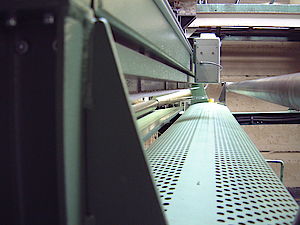Thickness measurement (ultrasonic)
From the mechanical arrangement of the sensors as a one or two sided and traversing thickness measurement the arrangement of the sensors in the ultrasound measurement is identical with the laser measurement.
In the UDM series of ultrasound systems an ultrasonic pulse is generated in the sensor and sent out to the material surface where it is reflected and received back by the same sensor.
Because we know the speed of sound in air the distance from the object surface and thus the thickness can be determined. Since the speed of sound of air changes very considerably with temperature, the ultrasonic sensors are equipped with online-temperature compensation. This is achieved by a reference post in front of the sensor which has a known distance which is measured with every measurement of the medium. If the reference distance changes due to a change in temperature the actual measurement can be compensated with this change. The advantages of ultrasonic measurement are:
- a good measurability of porous or coarsely structured surfaces by large integrating measuring spot
- totally independent of material colour and composition
- the measuring capability of transparent materials (glass)
From the mechanical arrangement of the sensors as a one or two sided and traver- sing thickness measurement the arrangement of the sensors in the ultrasonic measurement is identical with the laser measurement. The restrictions:
- Measurements should only be made at material temperatures of < 50°C des- pite the compensation.
- The measuring frequency of 200 Hz is way below that of the laser and no profile measurement is possible because of the size of the measuring spot.

